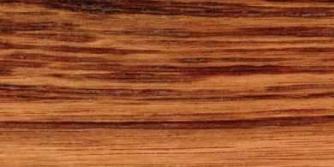 WALLABA
WALLABA

Wood Technology Transfer Fact Sheet
Eperua spp.
Wallaba
Family: Leguminosae
Other Common Names: Palo machete (Venezuela), Wallaba (Guyana), Walaba, Bijlhout (Surinam), Wapa (French Guiana), Apa, Apazeiro, Jebaro (Brazil).
Distribution: Centered in the Guianas but extends into Venezuela and the Amazon region of northern Brazil. Generally occurs in pure stands or as dominants, mostly on acid white sandy soils. Also common in creek valleys and in high savanna forest.
The Tree: Usually 80 to 90 ft high with trunk diameters 16 to 24 in. above the low buttresses. Boles straight, cylindrical, and clear to 40 to 60 ft. Heart rot common.
General Characteristics: Heartwood light to dark red to reddish- or purplish- brown with characteristic dark gummy streaks; sharply demarcated from the narrow grayish- or brownish- white sapwood, also streaked with gum. Texture rather coarse; grain typically straight; luster absent; taste not distinctive but with rancid odor when fresh which disappears on drying.
Weight: Basic specific gravity (ovendry weight/green volume) 0.78; air-dry density 58 pcf.
Mechanical Properties: (2-cm standard)
Moisture content Bending strength Modulus of elasticity Maximum crushing strength
(%) (Psi) (1,000 Psi) (Psi)
green (42) 15,100 2,180 8,380
12% 20,200 2,130 11,210
Janka side hardness 1,540 lb for green material and 2,040 lb at 12% moisture content.
Drying and Shrinkage: Wood dries very slowly with a marked tendency to check, split, and warp; honeycomb may develop in thick material. Kiln schedule T2-C2 is suggested for 4/4 stock and T2-C1 for 8/4. Air-drying should precede kiln-drying. Shrinkage green to ovendry: radial 3.6%; tangential 6.9%; volumetric 10.0%.
Working Properties: Though the wood has a high density, it is easy to work with hand and machine tools; however, high gum exudate clogs saw teeth and cutters. Once kiln dried, gum exudates are not a serious problem in machining; glues and polishes well.
Durability: Heartwood is reported to be very durable, resistant to subterranean termites, and fairly resistant to dry-wood termites. Resistance to marine borers is low.
Preservation: Extremely resistant to preservation treatments.
Uses: Heavy construction, railroad crossties, poles (sapwood peeled), industrial flooring, tank staves, and highly favored for charcoal.
 WALLABA
WALLABA








